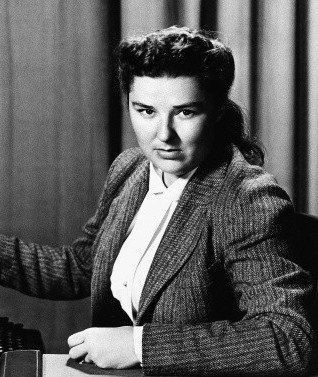Grace Metalious

Grace Metalious (September 8, 1924 – February 25, 1964) was an American author known for her controversial novel Peyton Place, one of the best-selling works in publishing history.
Marie Grace DeRepentigny was born into poverty and a broken home in the mill town of Manchester, New Hampshire. Writing from an early age, at Manchester Central High School, she acted in school plays. After graduation she married George Metalious in a Catholic church in Manchester in 1943, thus becoming a housewife and mother. The couple lived in near squalor but she continued to write. With one child, the couple moved to Durham, New Hampshire, where George attended the University of New Hampshire. In Durham, Grace Metalious began writing seriously. When George graduated, he took a position as principal at a school in Gilmanton, New Hampshire.[1]
In the fall of 1954, at the age of 30, she began work on a manuscript about the dark secrets of a small New England town. The novel had the working title The Tree and the Blossom.[2] By the spring of 1955, she had finished a first draft. By her husband’s account, both Metaliouses regarded The Tree and the Blossom as an unwieldy title and decided to give the town a name which could be the book’s title. They first considered Potter Place (the name of a real community near Andover, New Hampshire). Realizing their town should have a fictional name, they looked through an atlas and found Payton (the name of a real town in Texas). They combined this with Place and changed the “a” to an “e”. Thus, Peyton Place was born, prompting her comment, “Wonderful—that’s it, George. Peyton Place. Peyton Place, New Hampshire. Peyton Place, New England. Peyton Place, USA. Truly a composite of all small towns where ugliness rears its head, and where the people try to hide all the skeletons in their closets.”[1] Other accounts cite her publishers as changing the name.[3]
Metalious found an agent, M. Jacques Chambrun, who submitted the draft manuscript to three major publishers. In the summer of 1955 Leona Nevler, a freelance manuscript reader, read it for Lippincott and liked it but knew it was too steamy for a major publisher to accept. She showed it to Kathryn G. (“Kitty”) Messner, president and editor in chief of the small firm Julian Messner. Messner immediately acquired the novel and asked Nevler to step in as a freelance editor for final polishing before publication.[4]
In the summer of 1956, the Metalious family moved into a new hilltop house, and a publicity campaign was launched for the book, published September 24, 1956. Dismissed by most critics, it nevertheless remained on The New York Times bestseller list for more than a year and became an international phenomenon.
The town of Peyton Place was a combination of several New Hampshire towns: Gilmanton, the town where she lived (and which resented the notoriety); Laconia, the only nearby town of comparable size to Peyton Place and site of Metalious’ favorite bar; and the neighboring towns of Alton and Belmont. The village of Gilmanton Ironworks is where in December 1946, a daughter had murdered her sexually abusive father (upon which incident the book is partly based). The murder was investigated by the Sheriff of Belknap County, Sheriff Homer Crockett, and members of the New Hampshire State Police. Hollywood lost no time in cashing in on the book’s success—a year after its publication, the heavily sanitized movie Peyton Place was a major box office hit. The movie’s premiere was held at the Colonial Theatre in Laconia, New Hampshire. A prime time television series that began airing the fall after her death (on ABC-TV, from 1964 through 1969) was a ratings success as well.[5]
Metalious was promoted by her publisher in a photo captioned “Pandora in Blue Jeans”.[6] Commenting on her critics, she observed, “If I’m a lousy writer, then an awful lot of people have lousy taste,”[7] and as to the frankness of her work, she stated, “Even Tom Sawyer had a girlfriend, and to talk about adults without talking about their sex drives is like talking about a window without glass.”[8]
